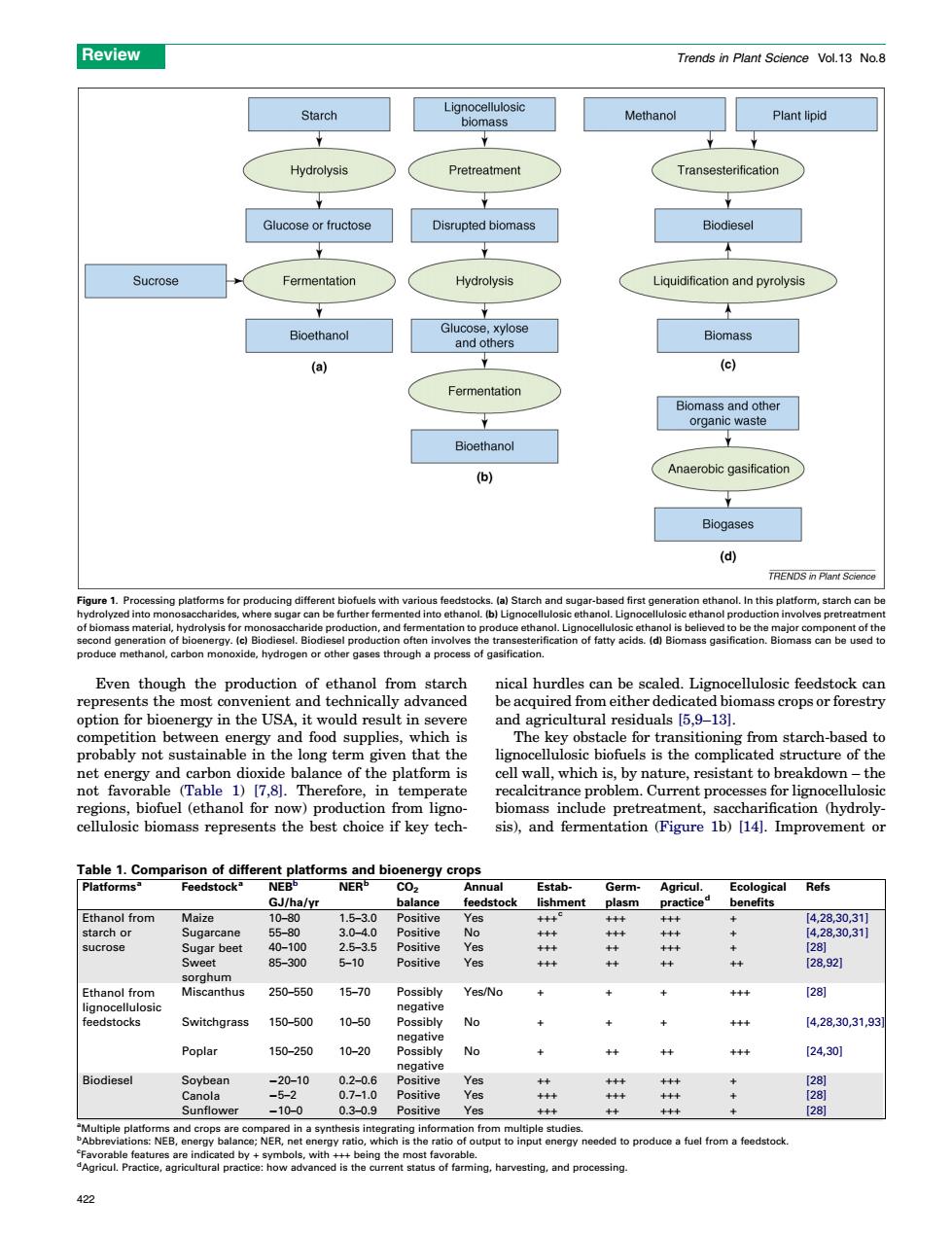正在加载图片...

Review Trends in Plant Science Vol.13 No.8 Starch Lignocellulosic biomass Methanol Plant lipid Hydrolysis Pretreatment Transesterification Glucose or fructose Disrupted biomass Biodiesel Sucrose Fermentation Hydrolysis Liquidification and pyrolysis Bioethanol Glucose,xylose and others Biomass (a) (c) Fermentation Biomass and other organic waste Bioethanol Anaerobic gasification (b) Biogases (d) TRENDS in Plant Science Figure 1.Processing platforms for producing different biofuels with various feedstocks.(a)Starch and sugar-based first generation ethanol.In this platform,starch can be hydrolyzed into monosaccharides,where sugar can be further fermented into ethanol.(b)Lignocellulosic ethanol.Lignocellulosic ethanol production involves pretreatment of biomass material,hydrolysis for monosaccharide production,and fermentation to produce ethanol.Lignocellulosic ethanol is believed to be the major component of the second generation of bioenergy.(c)Biodiesel.Biodiesel production often involves the transesterification of fatty acids.(d)Biomass gasification.Biomass can be used to produce methanol,carbon monoxide,hydrogen or other gases through a process of gasification. Even though the production of ethanol from starch nical hurdles can be scaled.Lignocellulosic feedstock can represents the most convenient and technically advanced be acquired from either dedicated biomass crops or forestry option for bioenergy in the USA,it would result in severe and agricultural residuals [5.9-131. competition between energy and food supplies,which is The key obstacle for transitioning from starch-based to probably not sustainable in the long term given that the lignocellulosic biofuels is the complicated structure of the net energy and carbon dioxide balance of the platform is cell wall,which is,by nature,resistant to breakdown-the not favorable (Table 1)[7,8].Therefore,in temperate recalcitrance problem.Current processes for lignocellulosic regions,biofuel (ethanol for now)production from ligno- biomass include pretreatment,saccharification (hydroly- cellulosic biomass represents the best choice if key tech- sis),and fermentation (Figure 1b)[14].Improvement or Table 1.Comparison of different platforms and bioenergy crops Platforms" Feedstock" NEB NERb C02 Annual Estab- Germ- Agricul. Ecological Refs GJ/ha/yr balance feedstock lishment plasm practiced benefits Ethanol from Maize 10-80 1.5-3.0 Positive Yes +++0 +++ +++ [4,28,30,31] starch or Sugarcane 55-80 3.0-4.0 Positive No +++ +++ +++ [4,28,30,311 sucrose Sugar beet 40-100 2.5-3.5 Positive Yes +++ +++ [28] Sweet 85-300 5-10 Positive Yes +++ ++ ++ [28,92] sorghum Ethanol from Miscanthus 250-550 15-70 Possibly Yes/No +++ [28 lignocellulosic negative feedstocks Switchgrass 150-500 10-50 Possibly No +++ [4,28,30,31.93 negative Poplar 150-250 10-20 Possibly No ++ ++ +++ [24,301 negative Biodiesel Soybean -20-10 0.2-0.6 Positive Yes ++ +++ +++ [28 Canola -5-2 0.7-1.0 Positive Yes +++ +++ +++ [28 Sunflower -10-0 0.3-0.9 Positive Yes +++ ++ +++ [28 Multiple platforms and crops are compared in a synthesis integrating information from multiple studies PAbbreviations:NEB,energy balance;NER,net energy ratio,which is the ratio of output to input energy needed to produce a fuel from a feedstock Favorable features are indicated by symbols,with +++being the most favorable. dAgricul.Practice,agricultural practice:how advanced is the current status of farming,harvesting,and processing. 422Even though the production of ethanol from starch represents the most convenient and technically advanced option for bioenergy in the USA, it would result in severe competition between energy and food supplies, which is probably not sustainable in the long term given that the net energy and carbon dioxide balance of the platform is not favorable (Table 1) [7,8]. Therefore, in temperate regions, biofuel (ethanol for now) production from lignocellulosic biomass represents the best choice if key technical hurdles can be scaled. Lignocellulosic feedstock can be acquired from either dedicated biomass crops or forestry and agricultural residuals [5,9–13]. The key obstacle for transitioning from starch-based to lignocellulosic biofuels is the complicated structure of the cell wall, which is, by nature, resistant to breakdown – the recalcitrance problem. Current processes for lignocellulosic biomass include pretreatment, saccharification (hydrolysis), and fermentation (Figure 1b) [14]. Improvement or Figure 1. Processing platforms for producing different biofuels with various feedstocks. (a) Starch and sugar-based first generation ethanol. In this platform, starch can be hydrolyzed into monosaccharides, where sugar can be further fermented into ethanol. (b) Lignocellulosic ethanol. Lignocellulosic ethanol production involves pretreatment of biomass material, hydrolysis for monosaccharide production, and fermentation to produce ethanol. Lignocellulosic ethanol is believed to be the major component of the second generation of bioenergy. (c) Biodiesel. Biodiesel production often involves the transesterification of fatty acids. (d) Biomass gasification. Biomass can be used to produce methanol, carbon monoxide, hydrogen or other gases through a process of gasification. Table 1. Comparison of different platforms and bioenergy crops Platformsa Feedstocka NEBb GJ/ha/yr NERb CO2 balance Annual feedstock Establishment Germplasm Agricul. practiced Ecological benefits Refs Ethanol from starch or sucrose Maize 10–80 1.5–3.0 Positive Yes +++c +++ +++ + [4,28,30,31] Sugarcane 55–80 3.0–4.0 Positive No +++ +++ +++ + [4,28,30,31] Sugar beet 40–100 2.5–3.5 Positive Yes +++ ++ +++ + [28] Sweet sorghum 85–300 5–10 Positive Yes +++ ++ ++ ++ [28,92] Ethanol from lignocellulosic feedstocks Miscanthus 250–550 15–70 Possibly negative Yes/No + + + +++ [28] Switchgrass 150–500 10–50 Possibly negative No + + + +++ [4,28,30,31,93] Poplar 150–250 10–20 Possibly negative No + ++ ++ +++ [24,30] Biodiesel Soybean 20–10 0.2–0.6 Positive Yes ++ +++ +++ + [28] Canola 5–2 0.7–1.0 Positive Yes +++ +++ +++ + [28] Sunflower 10–0 0.3–0.9 Positive Yes +++ ++ +++ + [28] a Multiple platforms and crops are compared in a synthesis integrating information from multiple studies. b Abbreviations: NEB, energy balance; NER, net energy ratio, which is the ratio of output to input energy needed to produce a fuel from a feedstock. c Favorable features are indicated by + symbols, with +++ being the most favorable. d Agricul. Practice, agricultural practice: how advanced is the current status of farming, harvesting, and processing. Review Trends in Plant Science Vol.13 No.8 422���